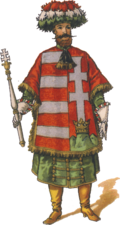
Back شعار المجر Arabic شعار المجر ARZ Macarıstan gerbi Azerbaijani Венгрия гербы Bashkir Герб Венгрыі Byelorussian Герб Вугоршчыны BE-X-OLD Герб на Унгария Bulgarian হাঙ্গেরীর চিনত্হান BPY Grb Mađarske BS Escut d'Hongria Catalan
| Coat of arms of Hungary | |
|---|---|
 | |
| Versions | |
  The coat of arms may also be used in other historical forms.[1] | |
 The official Hungarian state flag does not include the Hungarian coat of arms, but the variant with the coat of arms is often used during solemn occasions. | |
 | |
| Armiger | Hungary (lesser coat of arms) Tamás Sulyok, President of Hungary (greater coat of arms with two angels) Viktor Orbán, Prime Minister of Hungary (greater coat of arms with branches) |
| Adopted | 11 July 1990[2] |
| Crest | Holy Crown of Hungary |
| Shield | Barry of eight Gules and Argent, impaling Gules, on a trimount Vert a ducal coronet Or issuing therefrom a Patriarchal cross Argent |
The coat of arms of Hungary (Hungarian: Magyarország címere) was adopted on 11 July 1990,[3] after the end of communist rule. The arms have been used before, both with and without the Holy Crown of Hungary, sometimes as part of a larger, more complex coat of arms, and its elements date back to the Middle Ages.
The coat of arms of Hungary shall be a vertically divided shield with a pointed base. The left field shall contain eight horizontal bars of red and silver. The right field shall have a red background and shall depict a base of three green hills with a golden crown atop the central hill and a silver patriarchal cross issuing from the middle of the crown. The Holy Crown shall rest on top of the shield.
— Fundamental Law of Hungary – Foundation: Article I (1)[4]
The shield is split into two parts:
- The dexter (the right side from the bearer's perspective, the left side from the viewer's) features the so-called Árpád stripes, four Gules (red) and four Argent (silver) stripes. Traditionally, the silver stripes represent four rivers: Duna (Danube), Tisza, Dráva, and Száva.[5]
- The sinister (the left side from the bearer's perspective, the right side from the viewer's) consists of an Argent (silver) double cross on Gules (red) base, situated inside a small Or (golden) crown, the crown is placed on the middle heap of three Vert (green) hills, representing the mountain ranges (trimount) Tátra, Mátra, and Fátra.
Atop the shield rests the Holy Crown Hungary, the crown of King Saint Stephen of Hungary, the crown locates in the Hungarian Parliament Building in Budapest today.
- ^ "National Symbols: The Coat of Arms". www.keh.hu. Office of the President of the Republic. Archived from the original on 25 September 2021. Retrieved 12 February 2017.
- ^ "1990. évi XLIV. törvény a Magyar Köztársaság Alkotmányának módosításáról" [Act XLIV of 1990 on the Amendment of the Constitution of the Hungarian Republic]. hu.wikisource.org (in Hungarian).
- ^ "1990. évi XLIV. törvény a Magyar Köztársaság Alkotmányának módosításáról" [Act XLIV of 1990 on the Amendment of the Constitution of the Republic of Hungary]. mkogy.jogtar.hu – Törvények és országgyűlési határozatok [Laws and Parliamentary Resolutions]. Wolters Kluwer. 11 July 1990.
- ^ Fundamental Law of Hungary. 1 November 2024.
- ^ Betsy Dru Tecco: How to Draw Hungary's Sights and Symbols, The Rosen Publishing Group, New York, 2005 [1]